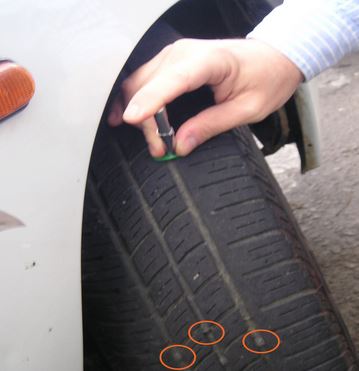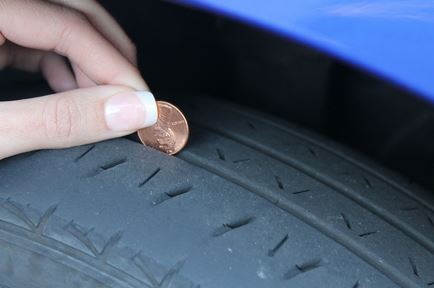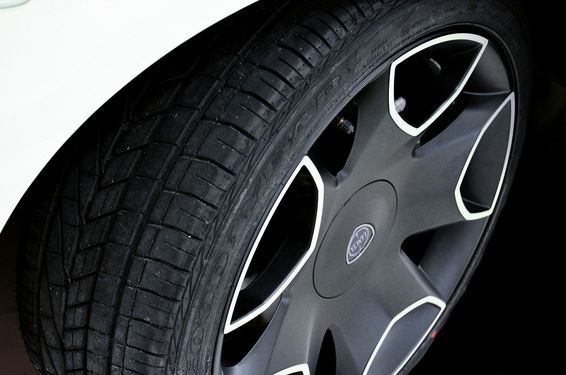When it comes to vehicle safety, tires are one of the most vital components of a car, and they’re often the most overlooked. It’s easy to drive for months and thousands of miles without remembering to check your tires. How often should tires be replaced and how can you tell if you need new tires? There are a few simple rules and techniques you can utilize to determine if your tires need to be replaced.
How Long Can Tires Last?
As a general rule, even if your tires don’t have a lot of visible wear, they should be replaced 10 years after their date of manufacture. The rubber compounds in a tire deteriorate with time regardless of use. Tires older than 10 years are far more prone to crack and blow out. While ten years is the general rule of thumb, many auto manufacturers recommend replacing tires after six years.
Truthfully, there is no easy way to put an expiration date on tires, because the lifespan of a tire can be affected by factors such as underinflation, storage, and heat, which will vary depending on owner care and driving conditions. After five years, most experts recommend getting your tires checked once a year by a specialist until you replace them. Maintaining correct air pressure and performing regular tire rotations can go a long way in increasing the longevity of your tires.
How To Self-Check Your Tires
While it’s always best to consult a professional, there are several techniques you can use to self-diagnose whether or not your tires are due for replacement.
Checking For Visible Wear Bars

A wear bar is, essentially, a bar (line) that runs through your tire perpendicularly that will appear in the grooves of the tire. Your tires should be changed before wear bars appear. If wear bars are showing, this is a good indicator that you should get new tires as soon as possible. Wear bars are built into every tire design and appear when tread is 2/32” of a tire remaining (10/32”-11/32” is typical for a traditional new tire tread).
The Penny Test

The penny test is designed to check your treads on your tires to see how much tire life you have left. Simply pick up a penny, and with Lincoln’s head upside down, place the penny in the groove of your tire. If you see the top of Lincoln’s head, you need new tires. If your tire covers the top of Lincoln’s head then you are all set and do not need to replace your tires.
The Depth Gauge Test
If you are not sure about the penny test result, there is an established depth gauge test that is far more accurate. Depth gauges are usually measured in 32/32nd. First, take the depth gauge and press it against a hard surface to make sure it zeroes out. Next, take the depth gauge and press the pointer into the tread (groove) of your tire and press down as far as possible. Compare the original tread wear of your tire (typically 10/32”-11/32”) to the measurement that you just took to see how much tread wear is used on your current tire’s life span.
Tire Balance & Alignment
If you feel any vibration or are experiencing a rougher ride than normal, your tire balance and alignment should be inspected. If either of these are off, you could be causing uneven wear on your tires while also reducing your gas mileage.
What Damages Tires?
There are a number of different causes for damaged tires. Ultimately, reasons for tire damage can be broken down into five main categories: Improper usage, lack of tire maintenance, driving habits, climate, and road conditions. Specific causes of tire damage can be found below.
Improper Usage:
- Mixed tire types
- The use of summer tires on snow and ice
- Placing tires on damaged wheels
- Rim sizes that aren’t compatible with wheel sizes
- Using tires with speed capabilities or load indexes lower than those specified by the vehicle manufacturer
- Reinflating a tire that has been seriously underinflated or run flat
Lack of Tire Maintenance
- Failing to regularly realign and rotate tires
- Improperly storing tires
- Using unapproved sealants
- Failing to regularly check air pressure
- Failing to balance tires after they are installed
Road Conditions
- Driving over rough potholes
- Hitting obstacles, curbs, or sharp objects
- Driving over large speed bumps too fast
- Riding across oil, grease, or other chemicals
Climate
- Extreme changes in temperature
- Rain, snow, or ice
- Strong sunlight
Driving Habits
- Speeding
- Failing to adapt appropriately to changes in road condition
- Performing quick starts and emergency braking
In addition to age related wear and tear, the aforementioned factors all play a role in damaging tires over time. While certain factors are out of a driver’s control, driving habits, tire usage, and tire maintenance can all be improved to extend the life of your tires.
Why Worry About Tread Wear?
Treads are especially important in Michigan where we have long winters with plenty of snow. Due to the harsh weather conditions and more snow and rain on the road, your tires work twice as hard and it may result in additional wear and tear. Healthy treads make it easier and safer to drive in snow and rain because they allow for more traction. If you don’t have proper winter tires or your treads are low, your tires are more apt to hydroplane on rainy days or slide on snow-covered roads.
Can A Spare Tire Be Used As A Tire Replacement?
In most cases, no, a spare tire is not designed to be a long-term replacement for a regular tire. Spare tires are developed to be lightweight, so they store easily in the back of your car. The lightweight construction means that spare tires don’t have the same speed or mileage capabilities that regular tires do.
Spare tires can affect your car’s stability and are more likely to blow out if driven for a long duration of time. The only time a spare tire can be used as a long-term tire replacement is if your spare tire is a full-size tire that matches the tires currently on your vehicle.
Does Car Insurance Cover Tire Replacement?
Tire replacement may be covered by your auto insurance policy depending on how your tires were damaged. If your tires were vandalized or stolen, you can file a claim with your insurance policy to have them replaced. The insurance company will likely subtract the degree of wear and tear from the value of the tires, so the settlement amount may not always equal the amount it costs to buy new tires.
If your tires were damaged by a pothole or road debris, insurance will likely also cover tire replacement if you have collision coverage. Collision coverage is an optional coverage feature that you would need to have added to your policy.
On the other hand, insurance won’t cover tire replacement if your tires need to be replaced due to tread wear, overinflation, or extreme temperatures. While tire replacement wouldn’t be covered in these circumstances, insurance may still reimburse you for any other damages caused by a tire blowout.
About Doyle & Ogden Insurance Advisors
Doyle & Ogden is a local, independent Grand Rapids auto insurance agency servicing drivers throughout the state of Michigan. Since 1958, our insurance advisors have helped drivers secure the best possible auto coverage for the right price. If you’re unhappy with your insurance rates or you’re looking for an auto insurance provider, our agents can provide you with a free complimentary quote. Contact us today by filling out a contact form or calling (616) 949-9000 to speak with an agent today.

